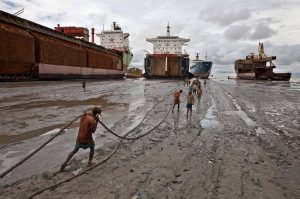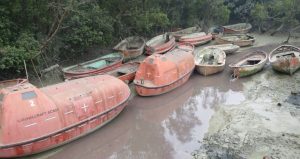The Al Nabila IV, a 27,000-dwt tonnage vegetable oil tanker, reaches her final resting place on Sitakunda beach near Chittagong in Bangladesh. After nearly 30 years of shipping, she is rammed onto Sitakunda beach at high tide and left to be disassembled by thousands of workers. The process will take about 5 months.
Firstly, the soft furnishings will be auctioned off to second-hand furniture companies. Beds, tables, and drawers find their way into domestic homes. Often wardrobes don’t have backs as they were previously bolted onto the ships’ walls, leading to a secondary industry of repair and renovation. Workers then climb up the hull to cut off large sections of metal, which are cut into smaller sections and rerolled into steel. The rerolling mills in Chittagong provide 90% of all steel consumed in Bangladesh.

Chittagong ship breaking yard (Fauzdahart Beach). Credit: Wikimapia
Different sections of the beach are roped off to mark different companies’ territories. The skeleton crew onboard Al Nabila IV must land in the correct place, or else the ship will belong to someone else. These companies choose Chittagong because it is the cheapest place to scrap ships, however the price is felt by the environment and the workers.
‘There is wide-spread knowledge of the irreparable damage caused by dirty and dangerous practices on tidal mudflats, yet profit is the only decisive factor for most ship owners when selling their vessels for breaking’- Ingvild Jenssen– executive director and founder of NGO Shipbreaking Platform
End-of-life vessels are wrought with hazardous materials, such as asbestos, heavy metals and PCBs, which bleed out of the ships and pollute the coastal environment. The work is also highly dangerous.
Workers face every occupational health and safety hazard, according to ILO, with 25% of the workforce underage and expected to work 12-16 hours per day. This involves climbing aboard vessels, removing large sections of metals with blowtorches, as well as daily exposure to hazardous materials. A report in 2013 highlighted that 2 workers per month were killed in shipyard accidents in Chittagong, with many more being injured.
Mohamed Edris is just one of these workers. While working on the Eurus London, a 19,6000-tonne container ship, the propeller he was removing sliced off his left leg, blinded him in one eye, and nearly broke his back. He lives in constant pain and is unable to go back to work.
Ship owners rarely provide the necessary documentation of the hazardous materials within the ship, therefore little precaution is taken when removing them. The toxic material ends up contaminating the beach, and the build-up of scraps from the ship contributes to the accumulation of rust and metal in soils.
It is reported that 20 years of shipbreaking leads to similar contamination levels to heavy industrial sites in use for 200 years in Europe. (Reddy et al 2004, Tewari et al 2001)
The pollutants are distributed along the coast and further inland due to the currents, tides, and during the monsoon season.
Below is an image of a polluted canal in a nearby fishing settlement where Nikhil Kaka lives. Nikhil Kaka is a Zele fishermen elder who explained that toxic residues, such as crude soils and other pollutants in the water, harm the fish populations and therefore local livelihoods. The environmental impacts are widespread.

An image of a polluted canal, February 2020. Credit: Camelia Dewan
Thousands of protected mangrove trees have been cut down to make space for additional ship-breaking yards. In 2019, 14,000 mangroves were illegally cut in Sitakund. The High Court of Bangladesh called for 4 shipbreaking yards to close and for the mangroves to be replanted. The yards stopped operating, but the mangroves were never replaced.
Muhammed Ali Hanin, of the Shipbreaking Platform in Bangladesh, describes how the law allows this damaging industry to continue. He says:
“EU laws stop EU-flagged ships being broken up on Asian beaches, but because owners can easily ‘reflag’ ships it has little strength.”
Reflagging ships is a common practice to avoid the proper implementation of international maritime standards.
St Kitts and Nevis, Comoros, Palau, and Tuvalu are the most popular end-of-life flag preferences. These flag registries often don’t have their own shipping companies but are responsible for a large proportion of end-of-life vessels. Dubbed ‘flags of conveniences’, these registries are often private companies located outside of the flag state, with profits shared between the company and the state of registration. They promise low-cost ‘last voyage’ packages and lack the resources – or will – to enforce international law effectively.
The Bangladesh industry argues that, if richer governments want ships to be dismantled safely, they should invest in improving conditions in the shipyards.
Groups such as the Chittagong Port Authority, have been set up to try and improve and develop the port, however, there is still a long way to go.
Despite the ‘green’ view of a circular economy resulting from the shipbreaking industry- with 99% of the ships being ‘recycled’– environmental degradation and poor working conditions prevail. The industry is harmful, but it is also the lifeline of the Bangladesh economy. It is unclear what the future looks like for this industry.
Featured image: Adam Cohn via Flickr